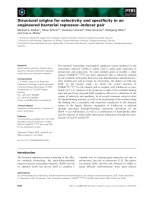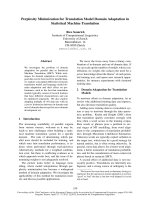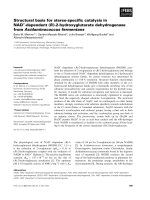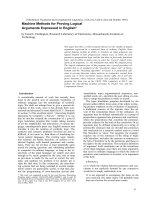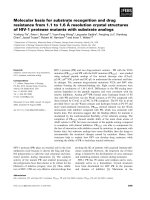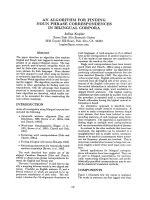Báo cáo khoa học: "Antithrombin supplementation for anticoagulation during continuous hemofiltration in critically ill patients with septic shock: a case-control study" pdf
Bạn đang xem bản rút gọn của tài liệu. Xem và tải ngay bản đầy đủ của tài liệu tại đây (361.01 KB, 7 trang )
Open Access
Available online />Page 1 of 7
(page number not for citation purposes)
Vol 10 No 2
Research
Antithrombin supplementation for anticoagulation during
continuous hemofiltration in critically ill patients with septic
shock: a case-control study
Damien du Cheyron
1
, Bruno Bouchet
1
, Cédric Bruel
2
, Cédric Daubin
1
, Michel Ramakers
1
and
Pierre Charbonneau
1
1
Medical Intensive Care Unit, Caen University Hospital, Avenue côte de Nacre, 14033 Caen cedex, France
2
Medical Intensive Care Unit, Bichat-Claude Bernard University Hospital, AP-HP, 46 rue Henri Huchard, 75018 Paris, France
Corresponding author: Damien du Cheyron,
Received: 21 Oct 2005 Revisions requested: 5 Dec 2005 Revisions received: 20 Dec 2005 Accepted: 13 Feb 2006 Published: 13 Mar 2006
Critical Care 2006, 10:R45 (doi:10.1186/cc4853)
This article is online at: />© 2006 du Cheyron et al.; licensee BioMed Central Ltd.
This is an open access article distributed under the terms of the Creative Commons Attribution License ( />),
which permits unrestricted use, distribution, and reproduction in any medium, provided the original work is properly cited.
Abstract
Introduction Acquired antithrombin III (AT) deficiency may
induce heparin resistance and premature membrane clotting
during continuous renal replacement therapy (CRRT). The
purpose of this study was to evaluate the effect of AT
supplementation on filter lifespan in critically ill patients with
septic shock requiring CRRT.
Methods We conducted a retrospective case-control analysis
based on a 4-year observational study with prospectively
collected data in two medical intensive care units in a university
hospital. In all, 106 patients with septic shock underwent CRRT
during the study period (55 during 2001 to 2002 and 51 during
2003 to 2004). Of these, 78 had acquired AT deficiency
(plasma level below 70%) at onset of renal supportive therapy,
40 in the first 2-year period and 38 in the last 2-year period. In
the latter intervention period, patients received AT
supplementation (50 IU/kg) during CRRT each time that plasma
AT activity, measured once daily, fell below 70%.
Results In a case-control analysis of the 78 patients with
acquired AT deficiency, groups were similar for baseline
characteristics, except in severity of illness as assessed by a
higher Simplified Acute Physiology Score (SAPS) II after 2002.
In comparison with controls, cases had a significantly greater AT
level after AT supplementation, but not at baseline, and a smaller
number of episodes of clots, without excess bleeding risk. The
median hemofilter survival time was longer in the AT group than
in the heparin group (44.5 versus 33.4 hours; p = 0.0045). The
hemofiltration dose, assessed by the ratio of delivered to
prescribed ultrafiltration, increased during intervention. AT
supplementation was independently associated with a decrease
in clotting rate, whereas femoral angioaccess and higher SAPS
II were independent predictors of filter failure. However,
mortality did not differ between periods, in the control period the
observed mortality was significantly higher than predicted by the
SAPS II score, unlike in the treatment period.
Conclusion In sepsis patients requiring CRRT and with
acquired AT deficiency, anticoagulation with unfractionated
heparin plus AT supplementation prevent premature filter
clotting and may contribute to improving outcome, but the cost-
effectiveness of AT remains to be determined.
Introduction
The incidence of septic shock has increased drastically during
past years. Septic shock patients have mortality rate of about
60% and an excess risk of death of about 25% when com-
pared with non-septic patients [1]. Sepsis patients frequently
develop endothelial damage and a hypercoagulable state
related to the systemic inflammatory response syndrome [2].
In these severe situations, patients present acquired anti-
thrombin III (AT) deficiency with plasma AT level lower than
80% either due to increased consumption related to dissemi-
APTT = activated partial thromboplastin time; AT = antithrombin III; CI = confidence interval; CRRT = continuous renal replacement therapy; DIC =
disseminated intravascular coagulopathy; ICU = intensive care unit; ROC = receiver operating characteristic; SAPS II = Simplified Acute Physiology
Score II; SOFA = Sequential Organ Failure Assessment.
Critical Care Vol 10 No 2 du Cheyron et al.
Page 2 of 7
(page number not for citation purposes)
nated intravascular coagulopathy (DIC) or induced by
decreased liver synthesis, or increased vascular permeability
and degradation by elastase [3]. A striking correlation
between AT activity and survival in sepsis has been demon-
strated [4-7]. Patients with multiple organ failure induced by
septic shock need aggressive life support such as vasopres-
sors, mechanical ventilation and/or renal supportive therapy.
Continuous renal replacement therapy (CRRT) requires care-
ful anticoagulation to prevent the blood from clotting while
avoiding bleeding complications. Heparin treatment, espe-
cially in combination with extracorporeal circulation, may also
lead to significant AT consumption [8], then to premature filter
clotting despite adequate anticoagulation [9]. In 2000 Wil-
liams and colleagues [10] showed, in a randomized trial in
patients requiring cardiopulmonary bypass, that heparin resist-
ance was frequently associated with AT deficiency. Treating
this deficiency with AT concentrate was more effective and
faster for obtaining adequate anticoagulation than using addi-
tional heparin. Cardiopulmonary bypass is a traumatic proce-
dure that is associated with platelet and coagulation defects,
and with systemic inflammation, as described in septic shock.
Thus we proposed that AT supplementation in the subset of
septic shock patients undergoing CRRT might increase filter
lifespan and improve the efficacy of this system of renal sup-
port.
Materials and methods
Setting and study cohort
This retrospective study was conducted over a 4-year period
(January 2001 to December 2004) in two 12-bed adult medi-
cal intensive care units (ICUs) in the University Hospital of
Caen. A total of 106 patients with septic shock, as defined by
the American College of Chest Physicians/Society of Critical
Care Medicine [11], underwent CRRT for more than 24 hours
during the study period. Demographic, clinical and laboratory
data, including criteria for overt DIC according to the Interna-
tional Society of Thrombosis and Haemostasis DIC algorithm
[12], as well as the Simplified Acute Physiology Score II
(SAPS II) [13] and the Sequential Organ Failure Assessment
(SOFA) score [14] to assess the severity of illness, were
recorded prospectively in a computer database. From January
2001 to December 2002, 55 patients needed CRRT in the
management of septic shock, with a crude filter clotting rate of
28.5%. Clotting was defined as a filter lifespan of less than 24
hours for those filters that were changed because of an
increased drop in transmembrane or end-to-end pressure. In
December 2002 we proposed that a decrease in filter lifespan
may be associated with low plasma AT activity. We used a
receiver operating characteristic (ROC) curve to determine
the threshold value of AT concentration with the highest sen-
sitivity and specificity to predict filter clotting. The area under
the curve of the ROC curve constructed with plasma AT val-
ues of these 55 patients was 0.886, suggesting that AT level
was a good predictor of filter clotting. From this ROC curve,
the optimal cutoff that distinguished patients with a higher and
lower risk of clotting was 70% (Figure 1). Indeed, the prelimi-
nary 40 patients with an AT activity of less than 70% had a
greater frequency of filter clotting than the 15 patients with an
AT activity of 70% or more (32% and 20%, respectively). Then
sepsis patients requiring CRRT after December 2002 (the
intervention period) were supplemented with AT if plasma
activity level decreased below the cutoff value, following
guidelines implemented in our ICU. Finally, only patients with
AT activity of less than 70% during both periods were
selected and compared in a case-control analysis. Ethical
approval for this study was granted by the hospital ethical
committee.
CRRT directives
Department protocol for continuous veno-venous CRRT indi-
cations followed standard recommendations. CRRT (Prisma
M100 preset AN69HF; Hospal, Lyon, France) was the tech-
nique of choice for hemodynamically unstable patients with
suspected dialysis-induced hypotension; CRRT was then
switched to intermittent hemodialysis as soon as possible.
Angioaccess was achieved through the use of 12F double-
lumen catheters inserted into the internal jugular or femoral
veins. Blood flow was adjusted to between 150 and 200 ml/
min, and ultrafiltrate at an outflow rate of 2 to 3 l/h was
replaced with bicarbonate buffer solution. Hemofilters were
primed with heparinized saline and changed every 72 hours.
Figure 1
Receiver operating characteristic (ROC) curve for antithrombin in a group of septic shock patients (n = 55) who underwent continuous renal replacement therapy in the intensive care unit from January 2001 to December 2002Receiver operating characteristic (ROC) curve for antithrombin in a
group of septic shock patients (n = 55) who underwent continuous
renal replacement therapy in the intensive care unit from January 2001
to December 2002. The ROC curve was generated by plotting sensitiv-
ity against (100 – specificity) for each value of AT. A threshold value of
70% with the highest sensitivity and specificity (88.9% and 87.9%,
respectively) was set to predict filter clotting. The area under the curve
is 0.886.
Available online />Page 3 of 7
(page number not for citation purposes)
Table 1
Baseline characteristics for the overall population and for controls and cases with AT level below 70%
Characteristic Overall population
(n = 106)
Period 1 (2001–2002)
(n = 40)
Period 2 (2003–2004)
(n = 38)
p
d
Age, years 59.6 ± 14.5 58.4 ± 14.5 60.5 ± 13.4 0.50
Male sex, n 70 (66) 27 (68) 27 (71) 0.81
Medical admission, n 85 (80) 33 (82) 30 (79) 0.78
Coexisting conditions, n
Chronic liver disease 16 (15) 6 (15) 7 (18) 0.77
Immune deficiency 20 (19) 8 (20) 7 (18) 1.0
Chronic renal failure 9 (8) 2 (5) 4 (11) 0.42
Site of infection, n 0.93
Respiratory system 61 (58) 22 (55) 22 (58)
Intra-abdominal 19 (18) 9 (22) 7 (18)
Urinary system 15 (14) 4 (10) 3 (8)
Other 11 (10) 5 (13) 6 (16)
Microbial type, n 0.89
Gram-negative 22 (21) 9 (22) 9 (24)
Gram-positive 32 (30) 10 (25) 12 (32)
Other/mixed 15 (14) 3 (8) 3 (8)
Unknown 37 (35) 18 (45) 14 (36)
SAPS II 58.2 ± 16.3 55.2 ± 16.0 62.5 ± 16.1 0.047
SOFA score 8 (3–21) 8 (3–20) 10 (3–21) 0.012
Overt DIC, n 20 (19) 7 (18) 8 (21) 0.78
Need for mechanical ventilation, n 82 (77) 30 (75) 30 (79) 0.79
Length of vasoactive support, days 6 (1–15) 6 (1–15) 6.5 (1–14) 0.79
Time between ICU admission and onset of CRRT, days 1 (0–7) 1 (0–7) 1 (0–7) 0.86
Serum creatinine
a
, µmol/l 158 (82–480) 126 (94–380) 158 (82–480) 0.47
Blood urea nitrogen
a
, mmol/l 16.2 (5.5–57) 15.9 (8.8–50.6) 17.6 (6.2–57) 0.20
Fibrinogen
a
, g/l 6.2 ± 1.4 6.5 ± 1.3 6.5 ± 1.4 0.86
Platelets
a
, 10
3
/µl 114 (8–654) 107 (8–570) 92 (11–654) 0.80
Antithrombin activity level
a
, % 62.5 ± 19.1 53.5 ± 10.4 51.9 ± 11.2 0.53
Femoral angioaccess, n 66 (62) 25 (62) 21 (55) 0.65
APTT ratio
b
2.2 ± 0.7 1.9 ± 0.5 2.0 ± 0.6 0.80
Heparin dose
b
, U/kg 771 ± 333 890 ± 389 683 ± 276 0.0086
Filter clotting rate, % 22 31.8 ± 25.0 16.5 ± 15.2 0.0018
Ultrafiltration rate, ml/kg per hour 34.1 ± 3.6 33.2 ± 3.4 34.4 ± 3.7 0.14
Ratio of delivered to prescribed ultrafiltration, % 83.1 ± 12.7 77.3 ± 12.3 86.1 ± 13.2 0.0032
Length of CRRT, days 4 (1–9) 4 (1–8) 4 (1–8) 0.85
Length of stay in ICU, days 10 (2–105) 8 (2–49) 11 (2–92) 0.22
Expected mortality, % 59.1 ± 24.1 54.0 ± 25.5 61.1 ± 23.8 0.21
ICU mortality, n 64 (60) 26 (65) 22 (58) 0.64
Hospital mortality, n 66 (62) 27 (68) 23 (60) 0.64
O/E ratio 1.1 [0.9–1.4] 1.4 [1.1–1.8]
c
1.1 [0.9–1.4]
a
When initiating CRRT;
b
means of APTT ratio and heparin dose during CRRT;
c
95% confidence interval significantly different from 1;
d
p value for
univariate analysis between periods 1 and 2. Single numbers in parentheses are percentages; ranges are shown in parentheses; square brackets
are used to indicate 95% confidence interval. APTT, activated partial thromboplastin time; CRRT, continuous renal replacement therapy; DIC,
disseminated intravascular coagulopathy; O/E ratio, risk-adjusted mortality rate; SAPS II, Simplified Acute Physiology Score II; SOFA, Sequential
Organ Failure Assessment.
Critical Care Vol 10 No 2 du Cheyron et al.
Page 4 of 7
(page number not for citation purposes)
Systemic anticoagulation was performed with pre-filter unfrac-
tionated heparin (target for activated partial thromboplastin
time (APTT) ratio 1.5 to 2.5 times normal; readjustment every
6 hours). Post-filter protamine (1 mg of protamine infused
intravenously per 100 IU of heparin) was added for patients at
high risk for bleeding, depending on the treating physician's
judgment.
Antithrombin supplementation
A blood sample was taken to measure plasma AT level at
onset of CRRT in all patients. A control blood test was per-
formed every day of treatment with continuous renal support.
AT activity levels were determined with a chromogenic assay
(bioMerieux antithrombin; bioMerieux, Marcy-l'Étoile, France;
normal values 80 to 120%). The supplementation protocol
sought to achieve a plasma AT level greater than 110 to
120%. Each time that AT activity dropped below 70% during
the intervention period, 50 IU/kg AT (Aclotine; LFB, Les Ullis,
France) were administered intravenously. The fixed daily 50 IU/
kg dose regimen of AT supplementation was chosen because
a 1.7% per IU/kg AT response and a mean half-life of 18.9
hours were expected in these patients, as reported [15].
Evaluation of antithrombin efficacy
The primary endpoint was the rate of filter clotting during
CRRT, defined as the number of clotting episodes divided by
the number of treatment days. Secondary endpoints were the
dose of hemofiltration (delivered to a prescribed ultrafiltration
ratio, defined as the 24-hour true cumulative ultrafiltration vol-
umes divided by the prescribed dose during the day), and the
mortality.
Statistical analysis
Values are expressed as means ± SD, median and range, or
number and percentage as appropriate. Univariate analysis
was performed with a χ
2
test and Fisher's exact test for cate-
gorical variables, and Student's t test or a Mann–Whitney test
when appropriate for continuous variables. Survival curves for
filters were prepared in accordance with the Kaplan–Meier
method. The dependant variable (72 hours survival) was
defined as success if the filter lifespan was greater than 72
hours. Backward deletion logistic regression analysis was per-
formed on the population restricted to the 78 patients
included in the case-control analysis to determine the set of
independent predictors of filter clotting in patients with
acquired AT deficiency. The dependant variable (filter clotting)
was defined as success if circuit coagulation occurred more
than once. We used p values of 0.1 to enter and remove vari-
ables from the model. The risk-adjusted mortality rate and 95%
confidence intervals (95% CIs) were calculated. Analysis was
performed with SAS 8.2 and MedCalc 7.4 statistical software.
The two-tailed significance level was set at p < 0.05.
Results
A total of 2,662 admissions of patients without septic shock
were made in our ICUs over the study period. Ages and SAPS
II scores were 54.8 ± 22.5 years and 38.6 ± 21.4, respec-
tively, and the crude ICU mortality rate was 20.6%. During the
same period, 230 admissions (7.9% of ICU admissions) con-
cerned patients with septic shock (age 58.7 ± 20.2 years;
SAPS II score 57.1 ± 22.0; ICU mortality 58.3%). Of these,
106 subjects (46%; age 59.6 ± 14.5 years; SAPS II score
58.2 ± 16.3) needed CRRT for a median duration of 4 days
(range 1 to 9), with a crude filter clotting rate of 22% and a
crude ICU mortality of 60% (Table 1). After exclusion of
patients as described in Materials and methods (see Figure 2),
78 (74%) septic shock patients requiring CRRT were eligible
for analysis.
In univariate analysis (Table 1), groups were similar for demo-
graphic data and co-morbidities. Modalities of CRRT, such as
hemofiltration (36 patients) or hemodiafiltration (42 patients),
did not differ between periods. Patients were more severely ill
in the period 2003 to 2004, as assessed by higher SAPS II
and SOFA scores at ICU admission. The number of overt DICs
did not differ between the two periods, and AT activity was
similar to baseline in both intervals; however, the mean AT
activity reached a normal level within 24 hours after AT supple-
mentation during the intervention period, and differed signifi-
cantly from that of controls (95 ± 20% for cases, 55 ± 12%
for controls; p = 0.001). During the intervention period, the
median dose of AT received per patient was 50 IU/kg (range
50 to 150). Nineteen patients received a single dose, 13
received two AT doses, and 6 needed three AT infusions once
daily, each dose being 50 IU/kg. AT supplementation was not
associated with an increased risk of major bleeding events (n
= 3 for cases; n = 2 for controls). The heparin dose required
to achieve the targeted increase in APTT was lower during the
intervention period (p = 0.0086). The frequency of post-filter
protamine infusion was equal between groups (four controls
versus five cases). Median lengths of CRRT and ultrafiltration
rate were similar, but the filter clotting rate was significantly
lower (p = 0.0018) and the ratio of delivered to prescribed
ultrafiltration was significantly greater (p = 0.0032) in patients
supplemented with AT.
As shown in Figure 3, the survival curve for filters in patients
supplemented or not with AT concentrates differed signifi-
cantly between periods. The median filter lifespan in patients
who received AT was 44.5 hours (95% CI 34.5 to 48.0),
which was significantly longer than the 32.5 hours (95% CI
26.5 to 36.0) in patients who received heparin alone (p =
0.0045 by the log-rank test).
By multivariable analysis adjusted for age, fibrinogen level,
heparin dose, platelet count and the need for mechanical ven-
tilation, AT supplementation was independently associated
with a decrease in membrane failure, whereas higher SAPS II
Available online />Page 5 of 7
(page number not for citation purposes)
and femoral angioaccess were identified as independent pre-
dictors of clotting (Table 2).
Despite a greater severity of illness during the intervention
period, the median lengths of ICU stay and the ICU mortalities
did not differ significantly. When adjusted for the severity of ill-
ness, mortality for patients treated with AT did not differ signif-
icantly from that calculated in control patients (the risk-
adjusted mortality rate was 1.1 for cases and 1.4 for controls,
with overlapping confidence intervals). However, the observed
hospital mortality rate was significantly higher than predicted
mortality estimated by SAPS II during the period 2001 to
2002 (95% CI significantly different from 1), whereas the
observed hospital mortality rate remained similar to the
expected rate during the intervention period.
Discussion
The recent conference on CRRT [16] failed to reach a consen-
sus on the preferred anticoagulant for most CRRT patients.
Systemic anticoagulation with unfractionated heparin remains
the treatment of choice. Some authors have reported encour-
aging results with the concomitant administration of prostag-
landin E
1
[17], or fresh frozen plasma [18] and unfractionated
heparin, to keep the circuit open. However, prostaglandin E
1
requires adequate experience to avoid side effects, and trans-
fusion with fresh frozen plasma presents the same risks as
transfusion with red blood cells and is not routinely recom-
mended during septic shock to correct laboratory clotting
abnormalities in the absence of bleeding or planned invasive
procedure [19]. More recently, a randomized trial has sug-
gested the superiority of regional citrate anticoagulation over
unfractionated heparin [20]. In this study, the median hemofil-
ter survival time increased markedly from 38.3 hours in the
heparin group to 124.5 hours in the citrate group. Decreasing
AT levels were identified as independent predictors of hemo-
filter failure, and citrate anticoagulation was associated with a
greater increase in AT over time after adjustment for temporal
changes in illness severity. Finally, these results advocated the
use of regional citrate as anticoagulation of choice in patients
receiving CRRT, and highlighted the key role of AT levels to
predict filter lifespan as described by others [8,9,21].
There are conflicting data on the use of AT in sepsis or extra-
corporeal circulation. On the one hand, the body of literature
currently does not support the routine use of AT in sepsis
patients despite encouraging results from experimental stud-
ies [22]. In 1998, a meta-analysis based on four double-blind
placebo-controlled trials of patients with severe sepsis docu-
mented a non-significant 22% decrease in death rate in
treated patients [23]. More recently, the KyberSept trial found
no effect of AT on 28-day all-cause mortality in patients with
severe sepsis or septic shock, despite a possible treatment
benefit in the subgroup of patients not receiving concomitant
heparin [24]. In this latter study, AT was associated with an
increased risk of hemorrhage when it was administered with
heparin. On the other hand, in heparin-resistant patients
undergoing cardiac surgery with cardiopulmonary bypass,
there are recent data suggesting that normalizing AT during
extracorporeal circulation may modulate thrombin generation,
decrease levels of fibrin monomer and D-dimer [25], restore
heparin responsiveness, and then promote therapeutic antico-
agulation [26,27].
Our observational study confirms the high incidence of septic
shock patients with a lack of AT activity as well as the strong
association between AT deficiency, heparin resistance and
premature circuit coagulation. It also suggests that AT supple-
mentation can effectively prevent the occurrence of clotting, at
least in part by potentiation of the heparin effect on thrombin
and factor Xa. This is substantiated by the decrease in heparin
dose needed to achieve targeted APTT during the second
two-year period. Finally, our results suggest that low AT levels
have first to be supplemented to take advantage of a new
membrane generation such as heparin-bonded filters.
Furthermore, as recently described by Lima and colleagues
[28], our study confirms the difficulties in predicting outcome
by using scoring systems at ICU admission in patients with
acute renal failure. Mortality was underestimated by SAPS II in
the control group of the present study and not in the treatment
group. This could indicate changes in the management of
treated patients that resulted in an improved outcome. The
potential impact of AT supplementation must therefore be
interpreted with caution. However, because patients were
more severely ill during the intervention period, the benefit of
AT on survival might have been underestimated, and AT might
contribute to an improvement in outcome as assessed by the
reduction of mortality adjusted for the severity of illness. In our
Figure 2
Study flow chartStudy flow chart.
Critical Care Vol 10 No 2 du Cheyron et al.
Page 6 of 7
(page number not for citation purposes)
study the ultrafiltration rate was about 35 ml/kg per hour and
did not differ significantly between periods. However, the
reduced downtime in treated patients contributed to an
enhancement in the daily dose of hemofiltration in patients
who received AT concentrates, as assessed by the ratio of
delivered to prescribed ultrafiltration. Because a beneficial
impact of higher dose of hemofiltration on survival of ICU
patients with acute renal failure treated by continuous hemofil-
tration has been well demonstrated [29], this mechanism
might be involved, at least in part, in improving the adjusted
mortality risk in our study.
Another finding is the association between femoral angioac-
cess and circuit coagulation. The femoral vein is usually con-
sidered the primary choice in emergencies, whereas internal
jugular access seems preferable in the absence of life-threat-
ening thoracic conditions. Our results further support the
placement of dialysis catheters in the internal jugular vein
whenever possible, to decrease the rate of complications such
as clotting and to improve the efficacy of hemofiltration. This
should be confirmed by a well-designed randomized trial.
Some limitations of our study have to be addressed. Because
the design was single-center and retrospective, with a com-
parison of unmatched small historical groups despite a pro-
spective collection of data, we recognize that the conclusions
drawn from the present study might not be generalizable. We
simply reported the evolution of the incidence of filter failure
between two periods during which only one element had
changed: the supplementation of AT in patients with an
endogenous AT activity of less than 70% during CRRT.
Finally, the cost of AT supplementation is high in our study.
Despite a decrease in the mean number of filters used, AT
(product and analysis) plus hemofilters in the second period
cost about €730 per treatment day compared with €80 per
treatment day for filters alone. However, the mean cost
increase of €650 per treatment day can be counterbalanced
by the time saved by nurses and intensivists, and by a potential
beneficial effect on outcome. Thus, although AT supplementa-
tion represents a real cost to the hospital, further randomized
studies are needed to evaluate its cost-effectiveness in septic
shock patients treated with continuous hemofiltration.
Conclusion
Our results suggest that AT administration in patients suffering
from septic shock-induced multiple organ failure and requiring
CRRT should be re-evaluated. As demonstrated in heparin-
resistant patients necessitating cardiopulmonary bypass dur-
ing cardiac surgery, AT supplementation may be used in the
future as an alternative to regional citrate anticoagulation to
improve the effect of heparin in patients undergoing CRRT
during septic shock. Its safety, cost-effectiveness and impact
on outcome remain to be determined by further double-blind,
randomized, placebo-controlled multicenter trials.
Competing interests
The authors declare that they have no competing interests.
Authors' contributions
DdC conceived the original protocol, executed the study, ana-
lyzed data, and drafted the manuscript. BB, CB, CD, MR
assisted in executing the study and drafting the final manu-
script. PC participated in the coordination of the study. All
authors read and approved the final manuscript.
Acknowledgements
The authors thank Dr Mehdi Bousta, Dr Mohamed Fekih-Hassen, Dr
Anne Lesage, Dr William Marie, Dr Abdel Ouchikhe, Dr Virginie Verrier
and Dr Sophie Vincent for their contributions to the management of
patients and to the collection of data for this study.
Table 2
Set of independent factors associated with filter clotting
determined by multivariable analysis
Factor Odds ratio 95% CI p
Antithrombin
supplementat
ion
0.21 0.06–0.74 0.0147
Femoral
angioaccess
4.32 1.32–14.15 0.0156
SAPS II 1.06 1.01–1.12 0.0150
Backward deletion logistic regression analysis. Age, fibrinogen,
heparin dose and platelets as continuous variables and the need for
mechanical ventilation as a categorical variable were introduced into
the model, then removed from the equation as described in Materials
and methods. An odds ratio of less than 1 means a decreased risk of
filter clotting. CI, confidence interval; SAPS II, Simplified Acute
Physiology Score II.
Figure 3
Survival curves of filters in patients with an AT of less than 70% accord-ing to AT supplementation (period 2) or not (period 1)Survival curves of filters in patients with an AT of less than 70% accord-
ing to AT supplementation (period 2) or not (period 1). The estimated
hazard ratio was 2.15 (95% confidence interval 1.29 to 4.02).
Available online />Page 7 of 7
(page number not for citation purposes)
References
1. Annane D, Aegerter P, Jars-Guincestre MC, Guidet B: Current
epidemiology of septic shock: the CUB-Rea Network. Am J
Respir Crit Care Med 2003, 168:165-172.
2. Balk RA: The systemic inflammatory response syndrome.
JAMA 1995, 274:127.
3. Seitz R, Wolf M, Egbring R, Havemann K: The disturbance of
hemostasis in septic shock: role of neutrophil elastase and
thrombin, effects of antithrombin III and plasma substitution.
Eur J Haematol 1989, 43:22-28.
4. Wilson RF, Mammen EF, Robson MC, Heggers JP, Soullier G,
DePoli PA: Antithrombin, prekallikrein, and fibronectin levels in
surgical patients. Arch Surg 1986, 121:635-640.
5. Fourrier F, Chopin C, Goudemand J, Hendrycx S, Caron C, Rime
A, Marey A, Lestavel P: Septic shock, multiple organ failure, and
disseminated intravascular coagulation. Compared patterns
of antithrombin III, protein C, and protein S deficiencies. Chest
1992, 101:816-823.
6. Lorente JA, Garcia-Frade LJ, Landin L, de Pablo R, Torrado C,
Renes E, Garcia-Avello A: Time course of hemostatic abnormal-
ities in sepsis and its relation to outcome. Chest 1993,
103:1536-1542.
7. Kinasewitz GT, Yan SB, Basson B, Comp P, Russell JA, Cariou A,
Um SL, Utterback B, Laterre PF, Dhainaut JF: Universal changes
in biomarkers of coagulation and inflammation occur in
patients with severe sepsis, regardless of causative micro-
organism [ISRCTN74215569]. Crit Care 2004, 8:R82-R90.
8. Salmon J, Cardigan R, Mackie I, Cohen SL, Machin S, Singer M:
Continuous venovenous haemofiltration using polyacryloni-
trile filters does not activate contact system and intrinsic coag-
ulation pathways. Intensive Care Med 1997, 23:38-43.
9. Singer M, McNally T, Screaton G, Mackie I, Machin S, Cohen SL:
Heparin clearance during continuous veno-venous haemofil-
tration. Intensive Care Med 1994, 20:212-215.
10. Williams MR, D'Ambra AB, Beck JR, Spanier TB, Morales DL, Hel-
man DN, Oz MC: A randomized trial of antithrombin concen-
trate for treatment of heparin resistance. Ann Thorac Surg
2000, 70:873-877.
11. Anonymous: American College of Chest Physicians/Society of
Critical Care Medicine Consensus Conference: Definitions for
sepsis and organ failure and guidelines for the use of innova-
tive therapies in sepsis. Crit Care Med 1992, 20:864-874.
12. Taylor FB Jr, Toh CH, Hoots WK, Wada H, Levi M: Towards def-
inition, clinical and laboratory criteria, and a scoring system for
disseminated intravascular coagulation. Thromb Haemost
2001, 86:1327-1330.
13. Le Gall JR, Lemeshow S, Saulnier F: A new Simplified Acute
Physiology Score (SAPS II) based on a European/North Amer-
ican multicenter study. JAMA 1993, 270:2957-2963.
14. Vincent JL, Moreno R, Takala J, Willatts S, De Mendonca A, Bruin-
ing H, Reinhart CK, Suter PM, Thijs LG: The SOFA (Sepsis-
related Organ Failure Assessment) score to describe organ
dysfunction/failure. On behalf of the Working Group on Sep-
sis-Related Problems of the European Society of Intensive
Care Medicine. Intensive Care Med 1996, 22:707-710.
15. Ilias W, List W, Decruyenaere J, Lignian H, Knaub S, Schindel F,
Keinecke HO, Heinrichs H, Thijs LG: Antithrombin III in patients
with severe sepsis: a pharmacokinetic study. Intensive Care
Med 2000, 26:704-715.
16. Kellum JA, Mehta RL, Angus DC, Palevsky P, Ronco C: The first
international consensus conference on continuous renal
replacement therapy. Kidney Int 2002, 62:1855-1863.
17. Kozek-Langenecker SA, Kettner SC, Oismueller C, Gonano C,
Speiser W, Zimpfer M: Anticoagulation with prostaglandin E1
and unfractionated heparin during continuous venovenous
hemofiltration. Crit Care Med 1998, 26:1208-1212.
18. Shulman RI, Singer M, Rock J: Continuous renal replacement
therapy. Keeping the circuit open: lessons from the lab. Blood
Purif 2002, 20:275-281.
19. Zimmerman JL: Use of blood products in sepsis: an evidence-
based review. Crit Care Med 2004, 32:S542-S547.
20. Kutsogiannis DJ, Gibney RT, Stollery D, Gao J: Regional citrate
versus systemic heparin anticoagulation for continuous renal
replacement in critically ill patients. Kidney Int 2005,
67:2361-2367.
21. Bastien O, French P, Paulus S, Filley S, Berruyer M, Dechavanne
M, Estanove S: Antithrombin III deficiency during continuous
venovenous hemodialysis. Contrib Nephrol 1995,
116:154-158.
22. Fourrier F, Jourdain M, Tournoys A: Clinical trial results with anti-
thrombin III in sepsis. Crit Care Med 2000, 28:S38-S43.
23. Eisele B, Lamy M, Thijs LG, Keinecke HO, Schuster HP, Matthias
FR, Fourrier F, Heinrichs H, Delvos U: Antithrombin III in patients
with severe sepsis. A randomized, placebo-controlled, double-
blind multicenter trial plus a meta-analysis on all randomized,
placebo-controlled, double-blind trials with antithrombin III in
severe sepsis. Intensive Care Med 1998, 24:663-672.
24. Warren BL, Eid A, Singer P, Pillay SS, Carl P, Novak I, Chalupa P,
Atherstone A, Penzes I, Kubler A, et al.: Caring for the critically ill
patient. High-dose antithrombin III in severe sepsis: a rand-
omized controlled trial. Jama 2001, 286:1869-1878.
25. Levy JH, Despotis GJ, Szlam F, Olson P, Meeker D, Weisinger A:
Recombinant human transgenic antithrombin in cardiac sur-
gery: a dose-finding study. Anesthesiology 2002,
96:1095-1102.
26. Lemmer JH Jr, Despotis GJ: Antithrombin III concentrate to treat
heparin resistance in patients undergoing cardiac surgery. J
Thorac Cardiovasc Surg 2002, 123:213-217.
27. Avidan MS, Levy JH, Scholz J, Delphin E, Rosseel PM, Howie MB,
Gratz I, Bush CR, Skubas N, Aldea GS, et al.: A phase III, double-
blind, placebo-controlled, multicenter study on the efficacy of
recombinant human antithrombin in heparin-resistant patients
scheduled to undergo cardiac surgery necessitating cardiop-
ulmonary bypass. Anesthesiology 2005, 102:276-284.
28. Lima EQ, Dirce MT, Castro I, Yu L: Mortality risk factors and val-
idation of severity scoring systems in critically ill patients with
acute renal failure. Ren Fail 2005, 27:547-556.
29. Ronco C, Bellomo R, Homel P, Brendolan A, Dan M, Piccinni P, La
Greca G: Effects of different doses in continuous veno-venous
haemofiltration on outcomes of acute renal failure: a prospec-
tive randomised trial. Lancet 2000, 356:26-30.
Key messages
• Acquired AT deficiency is frequently observed during
septic shock.
• In septic shock patients undergoing CRRT, a low level
of AT activity, with a threshold value of 70%, is associ-
ated with premature filter clotting.
• The body of literature does not recommend the routine
use of AT concentrate to treat heparin resistance during
CRRT.
• Our case-control observational study suggests that AT
supplementation during CRRT restores heparin respon-
siveness, decreases the filter clotting rate and may
improve outcome.
• Further double-blind, randomized, placebo-controlled
multicenter trials are warranted to confirm these find-
ings and determine the cost-effectiveness of AT supple-
mentation.

